In the News June 29
Deplorable U.S. Supreme Court Decision on Women’s Right to Abortion and Health Care
U.S. Supreme Court Decision and Importance of Affirming Women’s Rights

Demonstration outside U.S. Consulate in Toronto, June 25, 2022, affirms women’s abortion rights and denounces U.S. Supreme Court Decision
TML: Thank you for joining us. You were one of the main organizers of Canada’s 1970 Abortion Caravan which boldly affirmed women’s rights at that time, bringing women into the front lines of the fight for rights. Before we ask you about that, please tell us what you think about the decision of the Supreme Court of the United States (SCOTUS) to overturn its previous Roe v. Wade ruling of 1973.
Dawn Hemingway (Carrell): The Supreme Court decision constitutes an egregious attack on the women of the U.S. and their reproductive rights such as abortion, and is part of the broad government attacks on women and children across the country at both the federal and state levels. These attacks include lack of access to affordable health care and child care, other reactionary legislation denying reproductive rights, denial of paid maternity leave, unsafe conditions for children in schools, and forced detention of undocumented women and children at the border.
The Supreme Court decision in the U.S. also brings to the surface many significant challenges facing women in Canada in terms of affirming their reproductive rights. Abortion services are limited across the country with many women having to travel long distances without reimbursement to access these and other health services. Privatization and cutbacks by government continue to negatively impact the quality of health care for everyone. And a growing number of people in Canada, including migrant workers and undocumented workers, lack any health coverage at all.
The response of women in the U.S., in Canada and around the world to this attack has been to get into action in the hundreds of thousands to reverse this broad assault on their rights. Women are rising up to affirm their rights. And at the centre of this struggle is the striving for health care for all.
TML: Please tell us about your involvement in the organizing work in the late 1960s and early 70s regarding women’s health including abortion. We would like to hear about that experience and its impact.
DH(C): At that time, women, youth, workers and students – in fact, society as a whole – faced significant challenges at home and abroad. As young women, we were fighting for our rights, for appropriate living and working conditions (with many of us both workers and students); to end racism, sexism and wars of aggression in Viet Nam, Cambodia and other countries; for recognition of the hereditary rights of Indigenous peoples; for the rights and needs of older adults, those experiencing poverty and those with disabilities; and there were rising concerns about the environment. These were turbulent yet positive and forward-looking times.
Seeking out the ways to come together and organize ourselves to bring about meaningful change was at the top of our agenda. We were determined to use our own voices – to be our own change-makers – and women were in the forefront of these struggles. Women’s liberation groups were on the rise across Canada. Women’s health and reproductive rights were huge concerns. We felt strongly that the right to control our own bodies and to have free, accessible and appropriate health care for women – and for everyone – was an integral part of gaining control over our lives.
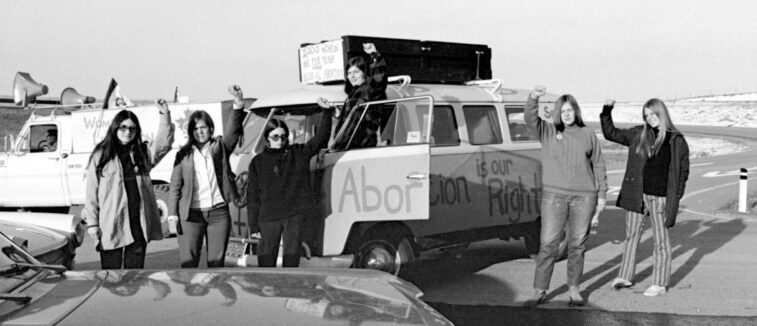
TML: And you were involved in the organizing specifically regarding abortion?
DH(C): Yes. One significant concern in the late 1960s was the fact that abortion remained an offence codified in Section 251 of the Criminal Code of Canada. This meant that many women, especially those with limited resources (and thus unable to travel to other jurisdictions outside of Canada), had no choice but to resort to “back street” abortions. Estimates at the time were that more than 2,000 women a year were dying in the course of these “procedures.” In 1969, Omnibus Bill C-150 was passed by the Pierre Trudeau government and was touted as being “legalization.” However, it required women to seek “approval” from a Therapeutic Abortion Committee (TAC) composed of three doctors who “decided” whether the pregnancy endangered the mental, emotional or physical health of the mother.
In addition to a woman not being able to make her own decision, what is often not mentioned is the fact that under the terms of this bill hospitals were neither required to have a TAC nor to perform abortions, not to mention the fact that huge areas and many communities in Canada didn’t have hospitals and abortion clinics were illegal. This was totally unacceptable so we decided to initiate a national campaign to mobilize women and everyone to put an end to the situation.
TML: What did the campaign entail?
DH(C): We undertook research into the structure of the medical profession and looked for alternate methods of medical organization other than the “free enterprise, fee-for-service method.” We raised questions about why unelected hospital boards and hospital abortion committees were making decisions about our lives – decisions that were ours to make. We condemned the practice of forced sterilization in Canada and abroad as well as using women in Asia, Africa and Latin America as “guinea pigs” for testing birth control and other related medical “research.”
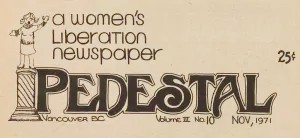 We demanded that abortion be removed from the Criminal Code and made available to all women as a basic human right, part of health care. Importantly, throughout this work we had our own newspaper – Pedestal – so that we could speak directly to and with women across the province and across the country about the campaign. The culmination of this work was the 1970 Abortion Caravan, a caravan of cars that left Vancouver and traveled from city to city across the country to our final destination, the House of Commons in Ottawa. Along the way we shared our newspaper, held meetings, debates, demonstrations and discussions that put the right to abortion and related health care issues in the spotlight everywhere.
We demanded that abortion be removed from the Criminal Code and made available to all women as a basic human right, part of health care. Importantly, throughout this work we had our own newspaper – Pedestal – so that we could speak directly to and with women across the province and across the country about the campaign. The culmination of this work was the 1970 Abortion Caravan, a caravan of cars that left Vancouver and traveled from city to city across the country to our final destination, the House of Commons in Ottawa. Along the way we shared our newspaper, held meetings, debates, demonstrations and discussions that put the right to abortion and related health care issues in the spotlight everywhere.
The Prime Minister and key Cabinet Ministers refused to meet with us, but this did not deter us.
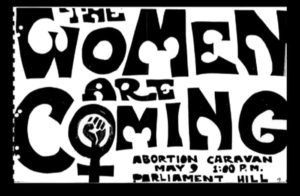 We organized a series of actions in Ottawa culminating with a large demonstration around the Centennial flame outside the Parliament building, with media everywhere. While the attention was focused on the demonstration, 17 of us made our way into the Parliament buildings (with mysteriously obtained passes) and settled into every section of the Visitor’s Gallery. Once situated, we began calling out to the MPs about the need to get abortion out of the Criminal Code.
We organized a series of actions in Ottawa culminating with a large demonstration around the Centennial flame outside the Parliament building, with media everywhere. While the attention was focused on the demonstration, 17 of us made our way into the Parliament buildings (with mysteriously obtained passes) and settled into every section of the Visitor’s Gallery. Once situated, we began calling out to the MPs about the need to get abortion out of the Criminal Code.
The MPs, clearly shocked and unhappy at our presence, and with only one women MP in the entire House of Commons at that time, Grace McInnis, had security called to have us removed. Much to their shock and our delight – they had failed to notice that we had chained ourselves to the gallery seats! Off they went for wire cutters while we continued presenting our demands.
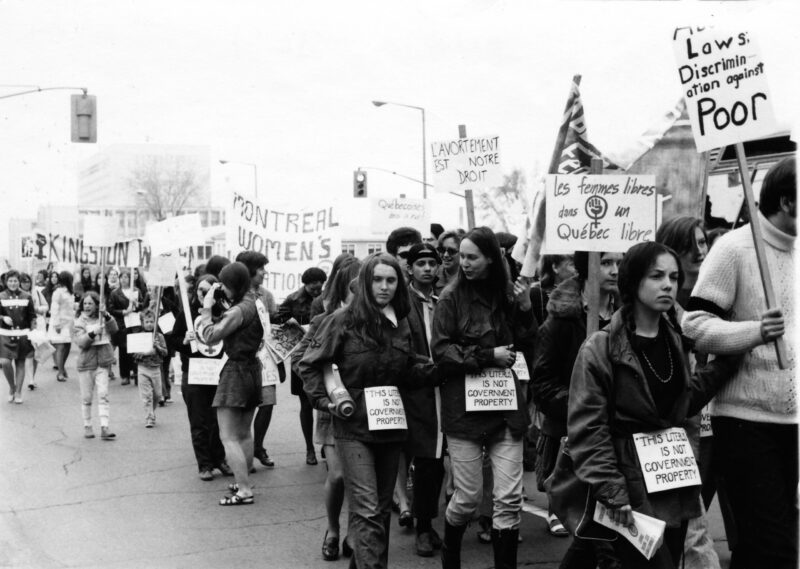 This culmination of the Abortion Caravan led to the closure of Parliament for the first time in Canadian history and laid groundwork for removal of abortion from the Criminal Code and for advances with respect to the broader right to health care for all. In the days following, newspaper headlines included: “Angry Women Halt Sitting of Parliament,” “Protesters Force House to Adjourn,” “After Women’s Invasion: Protective Shields Urged for MPs.”
This culmination of the Abortion Caravan led to the closure of Parliament for the first time in Canadian history and laid groundwork for removal of abortion from the Criminal Code and for advances with respect to the broader right to health care for all. In the days following, newspaper headlines included: “Angry Women Halt Sitting of Parliament,” “Protesters Force House to Adjourn,” “After Women’s Invasion: Protective Shields Urged for MPs.”
TML: Looking back, what final thoughts would you like to share?
DH(C): There is so much that could be said, but let me highlight three things which I think remain critical today.
First, we did investigation ourselves. We looked into the issues that we were organizing around and talking about. We developed our plans based on that knowledge and we established our own newspaper to be able to speak directly to the broader community.
Second, each of us offered our skills to take up work where we thought we could make the best contribution. For example, I was tasked with going across the country to lay the groundwork for the Caravan. Other women made sure our newspaper and other materials were always well done and available. Others organized meetings and discussions in the community. Still others contributed in the realm of theatre and arts. Everyone contributed in the ways they were best able.
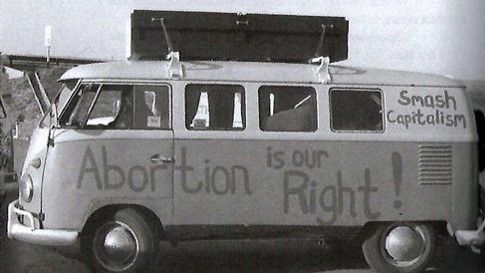 Finally, we had significant discussion among ourselves, not just about abortion or about health related issues, but about how these issues fit into achieving emancipation for women, and for everyone. A glimpse of this challenging discussion was apparent in the slogans painted on the VW Van in which I and others were traveling. On one side it said: “Abortion is Our Right!” and next to it was another slogan which simply said: “Smash Capitalism!”
Finally, we had significant discussion among ourselves, not just about abortion or about health related issues, but about how these issues fit into achieving emancipation for women, and for everyone. A glimpse of this challenging discussion was apparent in the slogans painted on the VW Van in which I and others were traveling. On one side it said: “Abortion is Our Right!” and next to it was another slogan which simply said: “Smash Capitalism!”
In regards to reproductive and other human rights, above all, the issue then as now is to get into action and fight for their affirmation.
TML: Thank you so much. It is thanks to the work of the women of the sixties that much headway was made not only at that time but since then.
TML Daily, posted June 29, 2022.

|

|

